Research Article Open Access
Biodegradation of Polycyclic Aromatic Hydrocarbons in Agricultural Soil Contaminated with Crude Oil from Nigeria Refinery using leurotus sajor-caju
| Ayodele Rotimi Ipeaiyeda1,*, Gloria Onyiinyechi Nwauzor1 and Samuel Omorovie Akporido2 | |
| 1Department of Chemistry, University of Ibadan, Ibadan, Nigeria | |
| 2Department of Chemistry, Delta State University, Abraka, Nigeria | |
| Corresponding Author : | Ayodele Rotimi Ipeaiyeda Department of Chemistry University of Ibadan, Nigeria Tel: +2348033948469 E-mail: ayosade2003@yahoo.com |
| Received: May 16, 2015 Accepted: June 29, 2015 Published: June 30, 2015 | |
| Citation:Ipeaiyeda AR, Nwauzor GO, Akporido SO (2015) Biodegradation of Polycyclic Aromatic Hydrocarbons in Agricultural Soil Contaminated with Crude Oil from Nigeria Refinery using Pleurotus sajor-caju. J Bioremed Biodeg 6: 301. doi:10.4172/2155-6199.1000301 | |
| Copyright: ©2015Ayodele RI, et al. This is an open-access article distributed under the terms of the Creative Commons Attribution License, which permits unrestricted use, distribution, and reproduction in any medium, provided the original author and source are credited. | |
| Related article at Pubmed, Scholar Google | |
Visit for more related articles at Journal of Bioremediation & Biodegradation
Abstract
Contamination by petroleum hydrocarbons has rendered soil from oil exploring areas in Nigeria unwholesome for agricultural practices. Because of the carcinogenic properties of the contaminant, its removal from soil is therefore an absolute necessity to promote a sustainable development for society and sound human health. Thus, a rapid cost effective method of biodegradation of Polycyclic Aromatic Hydrocarbons (PAHs) using Pleurotus sajor-caju was employed. Soil samples were collected from agricultural sites in Akpan town near Nigerian refineries and were analysed for sixteen PAHs by Gas Chromatography (GC). The total PAHs concentrations ranged from 56.8 to 112 mg kg-1. Using the ratios of phenanthrene to anthracene (Phe/Ant) and fluoranthene to pyrene (Flu/Pyr) to identify sources of contamination, PAHs concentrations in Akpan soils possibly had pyrogenic and petrogenic sources. These sources included crude oil petroleum combustion and spills. Pleurotus Sajor-Cajor offered significant reduction in PAHs concentrations after 6 weeks of incubation.
Remediation of soil contaminated with elevated levels of PAHs is of great importance to the inhabitants of Niger-Delta region of Nigeria due to proven pollution from oil spills. Non-remediated contaminated soil from this region does not fulfill the quality requirement as stipulated by Canadian soil quality guidelines and others from other countries for agricultural purpose. Reference is made to these guidelines since there is no national soil quality guideline for land use presently. With respect to this quality standards set by Canadian Council of Ministers of the Environment (CCME) [26], the maximum limit of PAHs in soil for agricultural purpose is 0.1 mg kg-1. So, there has been effort to find technical and economic solutions for this environmental issue. It is expedient, giving this background, to explore biodegradation of PAHs using fungi to remediate oil-spilt contaminated soil from the Niger-Delta region. Oil industries cited in this region have contributed greatly to the economy growth and development of the country. However, crude oil exploration activities have rendered this region severely damaged due to oil spills. Cases of oil spill resulting to gross pollution of soil with organic pollutants such as PAHs abound [27].
The ultimate objective of this research is to investigate the potential application of WRF Pleurotus for PAHs removal from crude oil contaminated soil. In this study, we report the PAHs concentrations in crude oil contaminated soil from Ekpan town near refinery in Delta State, Nigeria. Ex-situ biodegradation of PAHs in the soil using WRF Pleurotus sajor-caju, over incubation time, was also assessed. The choice of this fungus is due to its capacity to colonize a wide spectrum of wastes. Also, it has an advantage of growing over a wide range of temperatures especially in this temperate region.
Five farmlands were located as sampling points within Ekpan town. These farmlands were chosen to reflect PAHs levels of the soil receiving crude oil spills that constantly contaminate the land. Sampling of topsoil (0-15 cm) was done monthly using a stainless hand trowel for a period of three months denoted as A, B and C. Five composite samples were made from soils collected from transects of a farmland to make a total of twenty five composite samples for five farmlands in a month designated as SA. This purposive sampling scheme was repeated consecutively for two other months designated as SB and SC. Soils were also collected as control samples from the Botanical garden in the University of Ibadan. Each composite soil samples was air-dried, sieved and kept in glass bottles wrapped with an aluminium foil for PAHs analysis. A blank sample was incorporated for every five soil extracts analysed.
The cleaned fractions were analyzed for PAHs by a gas chromatography (GC). The GC model is HP 6890 equipped with flame ionization detector (FID) and powered with Chemstation Rev. A09.01 (1206) software, using a glass column (30 m length x 0.25 µm i.d) and column film (0.25 µm). Injector and detector temperatures were 250°C and 350°C respectively with nitrogen as mobile phase or carrier gas flowing at 30 psi. Hydrogen and compressed air pressures were 28 psi and 32 psi respectively. Detection limit (µg/g) was 1.0 for all PAHs. Recovery study was carried out by spiking an appropriate volume of known concentration of naphthalene standard in contaminated soil whose PAHs concentrations had been previously determined. The spiked soil was thoroughly homogenized and subjected to extraction procedure for PAHs determination. Experiment on recovery was replicated with five different soil samples and the average recovery was 91.7 ± 0.4% naphthalene.
The total PAHs concentrations were 112 mg/kg, 67.3 mg/kg and 56.8 mg/kg for SA, SB and SC respectively (Table 1). Surprisingly, PAHs concentrations in soils from this town were much higher in magnitude than what was reported (0.395 ± 0.190 mg/kg) as PAH concentration in a conventional farming site in Orgeval catchment of early industrialized region in France [28]. PAHs concentrations in soils from Ekpan town were compared with some environmental quality criteria for PAHs in soil released by the Netherlands Ministry, Canadian Councils of Ministers of Environment, British Columbia Ministry of Environments, for assessing risk of contaminated sites. The necessity for employing these standards stems from the fact that such environmental standards for PAHs in soil are not established yet in Nigeria.
The significance difference between PAHs concentrations measured and 0.1 mg/kg of PAHs set as the Canadian soil quality criterion for agricultural use [29] may possibly be due to pollution generated by crude oil exploration in Ekpan town. This implies that the soil is polluted with PAHs compounds and may pose risk to human health if cultivated for agricultural purpose. The inhabitants of Ekpan town may be predisposed to high risk of cancer due to long-term exposure to such compounds through bioaccumulation in the food chains. PAHs have very high lipid solubility and hence may quickly be absorbed into the gastrointestinal tract of humans [30,31]. More hydrocarbons were found in Ekpan soil contaminated possibly by spills when compared with soils from the control site (Botanical garden) as far as in Ibadan, which is usually uncontaminated.
Figures 2-5 give overview of studies on incubating contaminated soil with P. sajor-caju for 2-, 4- and 6 weeks respectively. PAHs were potentially biodegradable with the fungus. Significant reductions in all the PAHs concentration were observed with increase in incubation periods. The ranges of the extent of degradation in PAHs concentrations, between the incubation periods of two weeks to six weeks were indicated in the figures.
As a way to evaluate possible sources, the ratios of some PAHs compositions regarded as molecular indices were used to distinguish the natural and anthropogenic PAHs in soils [32,33]. The use of these molecular indices depends on the fact that PAHs distribution is dependent on temperature [33,34]. The PAHs distribution is governed by thermodynamic properties during low temperature processes such as catagenesis of organic matter leading to the formation of petroleum. On the other hand, their distributions are governed by kinetic properties during high temperature processes such as pyrolysis of organic matter [32].
The relative kinetic and thermodynamic stabilities of different PAHs molecules during their formations in petroleum source rocks under different heating or cooling conditions and by their comparable environmental fate were related to their distribution in substrates. So, the molecular indices were derived by evaluating the ratios of phenanthrene/anthracene (Phe/Ant) within the 3-ring PAHs group and fluoranthene/pyrene (Flu/Pyr) within the 4-ring PAHs [35]. Phenanthrene is much more stable than anthracene so that at low temperature molar fraction of phenanthrene produced is higher than that of anthracene. This might possibly explain higher levels of phenanthrene than that of anthracene as reflected in Figure 3. Consequent upon this, biodegradation of phenethrane by P. sajor-caju in terms of reduction in concentration (21.5-35.7%) was low compared to that obtained for the biodegradation of anthracene (35.9-47.9%).
Baumard et al. [36] proposed Phe/Ant ratio<10 and Flu/Pyr ratio>1 as quantitative indication of PAHs coming from pyrogenic source (such as petroleum combustion through a flare stack) and Phe/Ant ratio>15 and Flu/Pyr ratio<1 as indication of PAHs originating from petrogenic source (such as oil spill contamination). The Phe/Ant ratios in this study for all the samples ranged from 1.11 to 1.59 and Flu/Pyr ratios ranged from 0.70 to 0.78, indicating that there were both pyrogenic and petrogenic influences or input of PAHs on Ekpan soil samples. This implies that there is a natural leakage of oil related hydrocarbon in this study area. The basic concept of soil sorption of organic molecules suggests that the sorption of hydrophobic organic molecules is related to the organic matter derivable from organic carbon content of the soil [37].
Soil organic content varied from 3.28% to 5.80%. The results of regression analysis conducted to determine the relationship between the total PAHs concentrations and the soil organic contents showed positive exponential relationship with r2 of 0.8560. The relationship implies that high amounts of PAHs mainly occur in soil with high organic content.
References
- Samanta SK, Singh OV, Jain RK (2002) Polycyclic aromatic hydrocarbons: environmental pollution and bioremediation. Trends Biotechnol 20: 243-248.
- Wong JW, Wan CK, Fang M (2002) Pig manure as a co-composting material for biodegradation of PAH-contaminated soil. Environ Technol 23: 15-26.
- Loick N, Hobbs PJ, Hale MDC, Jones DL (2009) Bioremediation of poly-aromatic hydrocarbon (PAH)-contaminated soil by composting. Critical Reviews in Environmental Science and Technology 39: 271-332.
- Hao R, Wan HF, Song YT, Jiang H, Peng SL (2007) Polycyclic aromatic hydrocarbons in agricultural soils of the southern Subtropics, China. Pedosphere 17: 673-680.
- Wilcke W (2000) Polycyclic aromatic hydrocarbons (PAHs) in soil. Journal of Plant Nutrition and Soil Science 163: 229-248.
- Soclo HH, Budzinski H, Garrigues P, Matsuzawa S (2008) Biota accumulation of polycyclic aromatic hydrocarbons in Benin coastal waters. Polycyclic Aromatic Compounds 28: 112-127.
- Elliot E, Singhal N, Swift S (2011) Surfactants and Bacterial Bioremediationof Polycyclic Aromatic Hydrocarbon Contaminated Soil—Unlocking the Targets. Critical Reviews in Environmental Science and Technology 41:78-124.
- Yuan SY, Wei SH, Chang BV (2000) Biodegradation of polycyclic aromatic hydrocarbons by a mixed culture. Chemosphere 41: 1463-1468.
- Zhou Q, Shen B (2010) Biodegradation potential and influencing factors of a special microorganism to treat petrochemical wastewater. Petroleum Science and Technology 28: 135-145.
- Ilori MO, Adebusoye SA, Obayori OS, Oyetibo GO, Ajidahun O et al. (2011) Extensive biodegradation of Nigerian crude oil (Escavos light) by newly characterized yeast strains. Petroleum Science and Technology 29: 2191-2208.
- Dong Z, Lu M, Huang W, Xu X (2013) Aged petroleum – contaminated soil restoration and Benzo [a] pyrene biodegradation. Science and Technology 31: 1859-1865.
- Vasco MF, Cepero MC, Restrepo S, Vives-Florez MJ (2011) Recovery of mitosporic fungi actively growing in soils after bacterial bioremediation of oily sludge and their potential for removing recalcitrant hydrocarbons. International Biodeterioration and Biodegradation 65: 649-655.
- Librando V, Pappalardo M (2013) In silico bioremediation of polycyclic aromatic hydrocarbon: a frontier in environmental chemistry. J Mol Graph Model 44: 1-8.
- Adenipekun CO, Ipeaiyeda AR, Olayonwa AJ (2013) Bioremediation of soil contaminated with spent and fresh cutting fluids by Pleurotuspulmonarius (fries) Quelet. African Journal of Biotechnology 12: 6091-6097.
- Agamuthu P, Abioye OP, Aziz AA (2010) Phytoremediation of soil contaminated with used lubricating oil using Jatrophacurcas. J Hazard Mater 179: 891-894.
- Pointing SB (2001) Feasibility of bioremediation by white-rot fungi. Appl Microbiol Biotechnol 57: 20-33.
- Ferreira LF, Aguiar M, Pompeu G, Messias TG, Monteiro RR (2010) Selection of vinasse degrading microorganisms. World Journal of Microbiology and Biotechnology 26: 1613-1621.
- Kulikova NA, Klein OI, Stepanova EV, Koroleva OV (2011) Use of Basidiomycete in industrial waste processing and utilization technologies: fundamentals and applied aspects. Applied Biochemistry and Microbiology 47: 565-579.
- Hamman S (2004) Bioremediation capabilities of white rot fungi. Biodegradation 52: 1-5.
- Kahraman SS, Gurdal IH (2002) Effect of synthetic and natural culture media on laccase production by white rot fungi. BioresourTechnol 82: 215-217.
- Yesilada O, Cing S, Asma D (2002) Decolourisation of the textile dye Astrazon Red FBL by Funaliatrogii pellets. BioresourTechnol 81: 155-157.
- Jauregui J, Valderrama B, Albores A, Vazquez-Duhalt R (2003) Microsomal transformation of organophosphorus pesticides by white rot fungi. Biodegradation 14: 397-406.
- Márquez-Rocha FJ, Hernández-Rodríguez VZ, Vazquez-Duhalt R (2000) Biodegradation of soil-adsorbed polycyclic aromatic hydrocarbons by the white rot fungi Pleurotusostreatus. Biotechnology Letters 22: 469-472.
- Pickard MA, Roman R, Tinoco R, Vazquez-Duhalt R (1999) Polycyclic aromatic hydrocarbon metabolism by white rot fungi and oxidation by Coriolopsisgallica UAMH 8260 laccase. Appl Environ Microbiol 65: 3805-3809.
- Retes-Pruneda JL, Davila-Vazquez G, Medina-Ramírez I, Chavez-Vela NA, Lozano-Alvarez JA, et al. (2014) High removal of chemical and biochemical oxygen demand from tequila vinasses by using physicochemical and biological methods. Environ Technol 35: 1773-1784.
- CCME (Canadian Council of Ministers of the Environment) (2007) Canadian soil quality guidelines for the protection of environmental and human health: Summary tables. Updated September, 2007. In: Canadian environmental quality guidelines, 1999, Canadian Council of Ministers of the Environment, Winnipeg.
- Association of Official Analytical Chemists (AOAC) (1990) Official Methods of Analysis. Washington DC: Association of Official Analytical Chemists.
- Besalatpour A, Hajabbasi MA, Khoshgoftarmanesh AH, Dorostkar V (2011) Land farming process effects on biochemical properties of petroleum-contaminated soil. Soil and Sediment Contamination 20: 234-248.
- Gateuille D, Evrard O, Lefevre I, Moreau-Guigon E, Alliot F, et al. (2014) Mass balance and decontamination times of Polycyclic Aromatic Hydrocarbons in rural nested catchments of an early industrialized region (Seine River basin, France). Sci Total Environ 470: 608-17.
- BCME (British Columbia Ministry of the Environment) (1996) Overview of CSST procedures for the derivation of soil quality matrix standards for contaminated sites. Victoria, Canada’ BCME, Risk Assessment Unit; 51 pp.
- Johnsen AR, Wick LY, Harms H (2005) Principles of microbial PAH-degradation in soil. Environ Pollut 133: 71-84.
- Sanders M, Sivertsen S, Scott G (2002) Origin and distribution of polycyclic aromatic hydrocarbons in surficial sediments from the savannah river. Arch Environ Contam Toxicol 43: 438-448.
- Tang L, Tang XY, Zhu YG, Zheng MH, Miao QL (2005) Contamination of polycyclic aromatic hydrocarbons (PAHs) in urban soils in Beijing, China. Environ Int 31: 822-828.
- Yongtao L, Fangbai L, Tianbin Z, Guoyi Y, Junjian C et al. (2007) Pollution assessment, distribution and sources of PAHs in agricultural soils of Pearl River Delta-The biggest manufacturing base in China. Journal of Environmental Science and Health, Part A: Toxic/Hazardous Substances and Environmental Engineering 42: 1979-1987.
- Beenish S, Imran H, Mohammed AA, Habib N, Sher JK (2012) Distribution, toxicity level and concentration of polycyclic aromatic hydrocarbons (PAHs) in surface soil and groundwater of Rawalpindi, Pakistan. Desalination and Water Treatment 49: 240-247.
- Baumard P, Budzinski H, Michon Q, Garrigues P, Burgeot T et al. (1998) Origin and bioavailability of PAHs in the Mediterranean Sea from mussel and sediment. Estuarine, Coastal Shelf Science 47: 77-90.
- Boehm PD, Burns WA, Page DS, Bence AE, Mankiewicz PJ et al. (2002) Total organic carbon, an important tool in an holistic approach to hydrocarbon source fingerprinting. Environmental Forensics 3: 243-50.
Tables and Figures at a glance
| Table 1 |
Figures at a glance
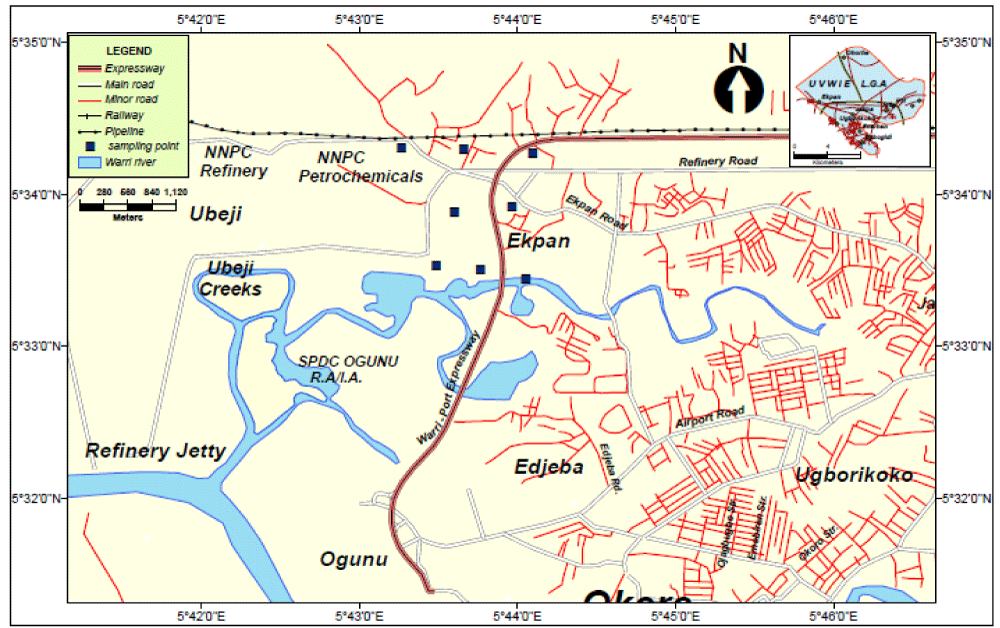 |
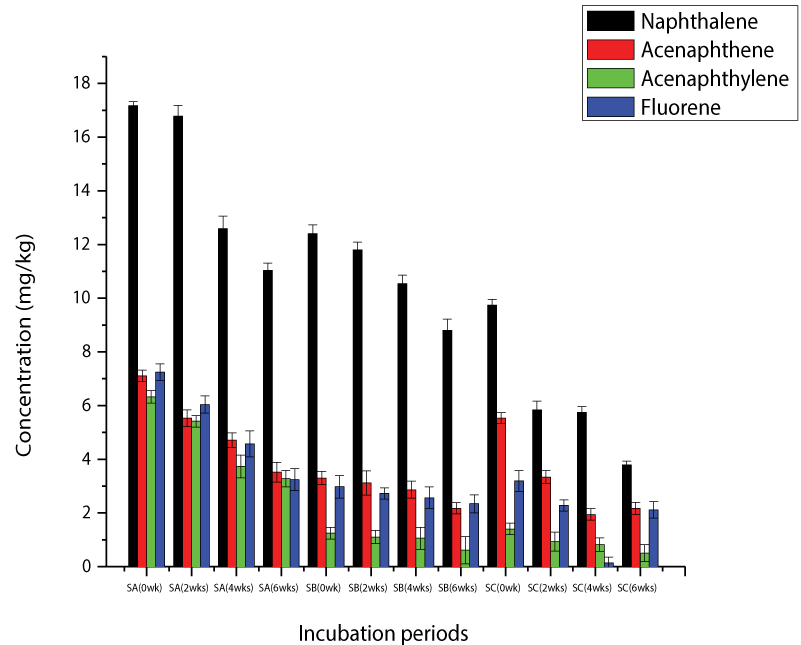 |
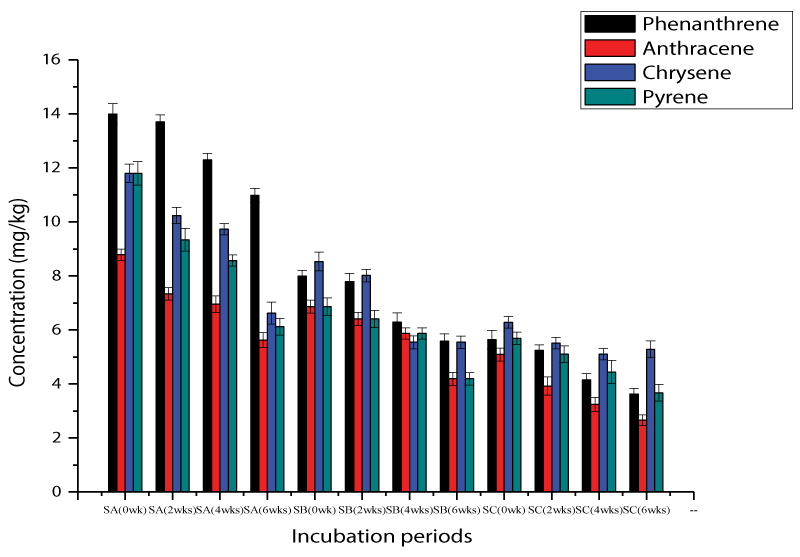 |
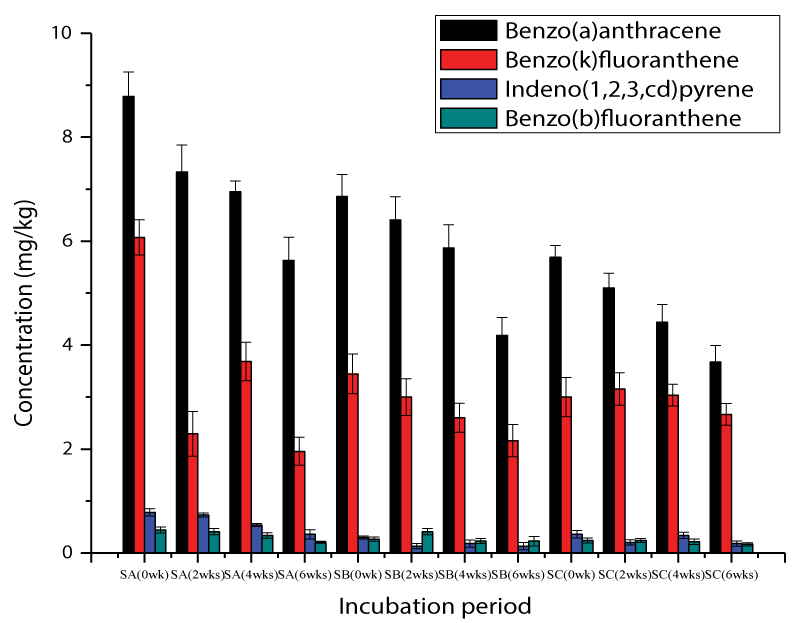 |
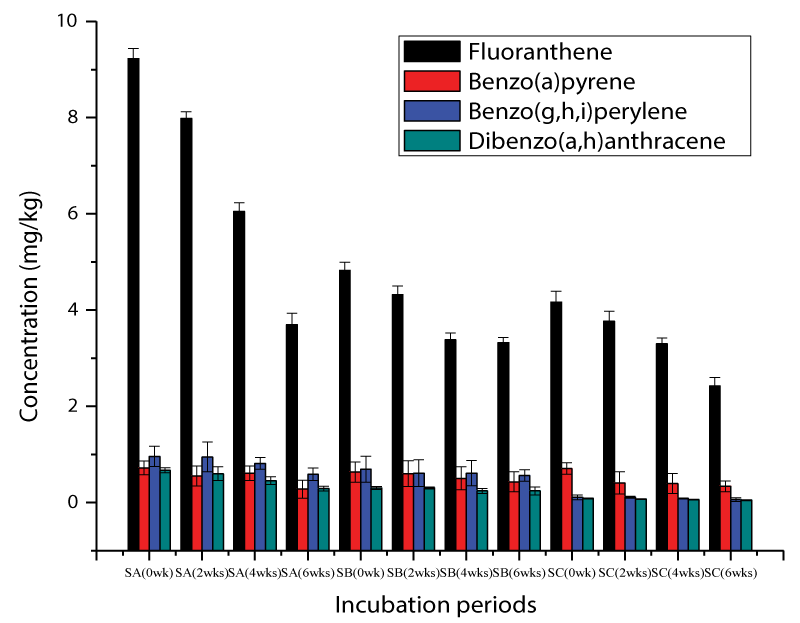 |
| Figure 1 | Figure 2 | Figure 3 | Figure 4 | Figure 5 |
Relevant Topics
- Anaerobic Biodegradation
- Biodegradable Balloons
- Biodegradable Confetti
- Biodegradable Diapers
- Biodegradable Plastics
- Biodegradable Sunscreen
- Biodegradation
- Bioremediation Bacteria
- Bioremediation Oil Spills
- Bioremediation Plants
- Bioremediation Products
- Ex Situ Bioremediation
- Heavy Metal Bioremediation
- In Situ Bioremediation
- Mycoremediation
- Non Biodegradable
- Phytoremediation
- Sewage Water Treatment
- Soil Bioremediation
- Types of Upwelling
- Waste Degredation
- Xenobiotics
Recommended Journals
Article Tools
Article Usage
- Total views: 15602
- [From(publication date):
July-2015 - Aug 28, 2025] - Breakdown by view type
- HTML page views : 10712
- PDF downloads : 4890
